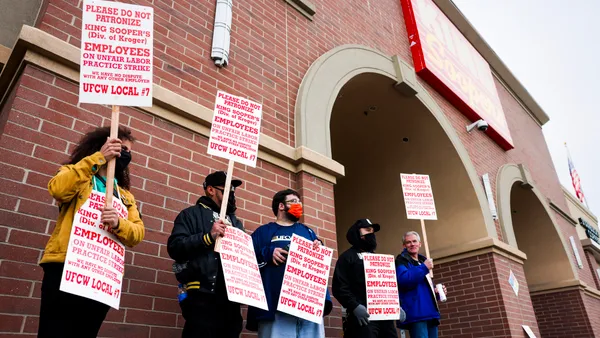UPDATE: Nov. 2, 2021: Southeastern Grocers (SEG) submitted a request to the Securities and Exchange Commission on Oct. 29 that the agency withdraw the company's S-1 registration for an initial public offering. The filing effectively ends Southeastern's latest bid to go public.
UPDATE: Jan. 29, 2021: Southeastern Grocers announced Thursday it's postponing its initial public offering launched last week. The company didn't provide a reason, and a company spokesperson wasn't immediately available to comment on the matter.
Reuters, citing a source familiar with the public offering, reported the decision reflected a lack of demand for shares at the price range Southeastern set down.
The grocer had priced 8.9 million shares of common stock at an anticipated price of $14 to $16 a share. In its updated S-1 form this week, Southeastern said it had been approved to use the "SEGR" market listing on the New York Stock Exchange. It estimated comparable store sales for the 52-week period ended Dec. 30, 2020, increased 16.3%, while net earnings were between $343.5 million and $411.5 million, compared to a net loss of $116.2 million for the previous year, which ended Dec. 25, 2019.
Dive Brief:
- Southeastern Grocers launched an initial public offering Thursday of 8.9 million shares of common stock at an anticipated price of between $14 and $16 a share, according to a company announcement.
- The shares will be sold by select company stakeholders, and Southeastern said it will not sell any stock or receive any net proceeds from the offering. The grocer, which has applied to list on the New York Stock Exchange under the symbol "SEGR," said it will grant underwriters a 30-day option to purchase up to an additional 1,335,000 shares of common stock.
- Southeastern has restructured its finances and streamlined its store count on its march to the public markets, and is eager to further capitalize on the booming sales it and other grocers enjoyed in 2020.
Dive Insight:
Southeastern Grocers, which notified the Securities and Exchange Commission in September that it was thinking of going public, is moving ahead with an IPO after working for several years to rehabilitate its business and present a compelling picture to potential investors.
In an updated S-1 filing, Southeastern stated it had $351 million in total debt as of Dec. 31, down from $781 million at the end of 2019. It estimated net sales for fiscal 2020 will reach $9.6 billion, up from $8.3 billion in 2019, while comparable store sales for the year rose 16.3% thanks to high demand during the pandemic.
Southeastern said it plans to open 10 new stores per years beginning in 2022, and that it will continue to refresh stores, invest in e-commerce and evolve its product assortment. The grocer estimates it will have remodeled 55% of its store base between fiscal 2016 and fiscal 2020, and plans to refresh another 42% of its stores over the next four years. It offers delivery from roughly two-thirds of its locations and will have rolled out 400 new private label products during fiscal 2020.
The grocer said it will continue to evaluate potential acquisitions to strengthen its market share, and noted that, despite the dominance of competitor Publix and rush of new competitors into Florida, it sees numerous expansion opportunities in its home state.
"We believe multiple key markets within Florida are underpenetrated relative to the national average," the company said in its filing.
The company also announced the appointment of a new board member, Jodi Kahn, who has worked as an industry consultant and was chief consumer officer at e-grocer FreshDirect from 2013 to 2016.
Southeastern spent several months in bankruptcy in 2018 as it struggled with hundreds of millions of dollars of debt that hobbled its ability to invest in its stores and put it at a competitive disadvantage. The bankruptcy filing followed an aborted effort by Southeastern to go public in 2014.
Southeastern has spent the time since it came out of bankruptcy becoming leaner and more focused on strengthening its flagship Winn-Dixie brand. In 2020, Southeastern agreed to sell 85 stores it ran under the Bi-Lo and Harveys banners to rivals including Food Lion, Alex Lee and B&T Foods. Those moves that simultaneously helped the company sharpen its focus and bring in much-needed cash.
Additionally, Southeastern said last year that it would drop the Bi-Lo banner, a change that amplifies efforts to define itself as the owner of Winn-Dixie, the storied Florida chain that competes head-on with Publix. The decision represented a key shift for Southeastern, which entered its current corporate structure in 2012 when Winn-Dixie, then a separate publicly traded company, merged with Bi-Lo.
Southeastern has been working to expand the Winn-Dixie chain even as it has sold other stores. The company is converting eight stores it bought from Lucky’s Market and Earth Fare when those chains ceased operations last year.
Investors who look at buying shares in Southeastern may look at Albertsons, which went public in June, for guidance as to how the stock market might treat a new entrant from the grocery industry. Albertsons sold 50 million shares at $16 per share, below its initial estimate that stock in the company would start trading in the $18-to-$20 range. Shares in Albertsons, which have traded in a tight range even as the grocer has reported exceptionally strong sales during the pandemic, have recently begun to rise, closing Wednesday at $17.33 on the New York Stock Exchange.














